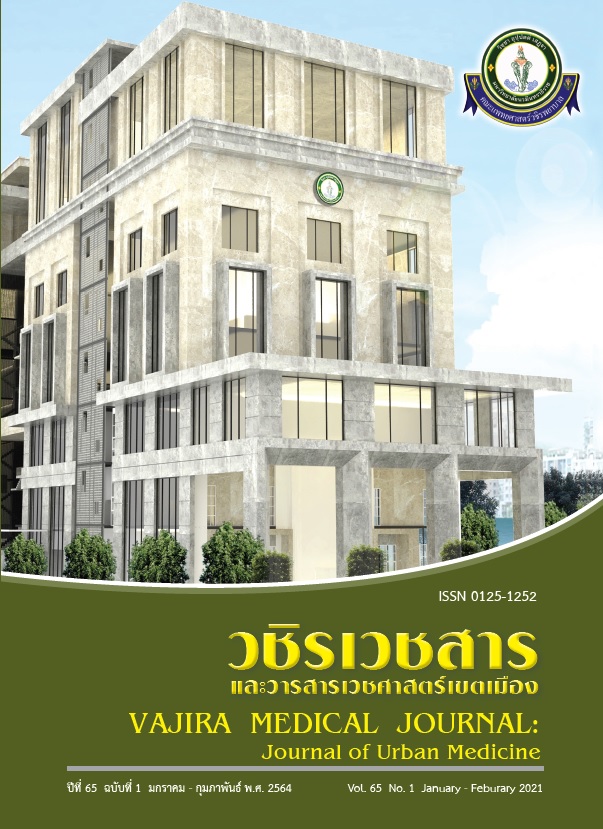Prevalence and Factors Related to Metabolic Syndrome in Personnel of Somdejphrajaotaksinmaharaj Hospital
Main Article Content
Abstract
Objective: To study prevalence and factors related to metabolic syndrome in personnel of Somdejphrajaotaksinmaharaj Hospital
Method: This was a descriptive research. The sample was 805 personnel of Somdejphrajaotaksinmaharaj hospital who received annual health checks up in 2019. The data were collected from medical records and questionnaire which included general characteristics and personal behavioral factors. Descriptive statistics and inferential statistics were used. Univariate analysis and multiple logistic regressions were used for identifying risk factors and presenting adjusted odds ratio (ORadj).
Results: The results showed that the prevalence of metabolic syndrome was 15.80% among Somdejphrajaotaksinmaharaj hospital personnel. The statistically significant factors related to the metabolic syndrome by using the univariate were the gender, age, disease, smoking, alcohol drinking and exercise frequency (p<0.05). Male were found to at risk of metabolic syndrome 3.10 times (95% CI: 1.71-5.63) more than female. Over 45 years of age were found to at risk of metabolic syndrome 2.35 times (95% CI: 1.27-4.33) more than lower than 45 years. Underlying diseases were found to at risk of metabolic syndrome 5.65 times (95% CI: 3.05-10.45) more than absence of underlying diseases. Smoking were found to at risk of metabolic syndrome 2.24 times (95% CI: 1.05-4.78) more than non-smoking. Alcohols drinking were found to at risk of metabolic syndrome 1.93 times (95% CI: 1.11-3.37) more than non-alcohols drinking. Exercise frequency lower than 3 day were found to at risk of metabolic syndrome 0.45 times (95% CI: 0.26-0.78) more than exercise frequency over 3 day. The factors related to the metabolic syndrome by using the multiple logistic regressions were gender, disease and exercise frequency (p<0.05). Male were found to at risk of metabolic syndrome 0.39 times (95% CI: 0.19-0.95) more than female. Underlying diseases were found to at risk of metabolic syndrome 0.20 times (95% CI: 0.10-0.39) more than absence of underlying diseases. Exercise frequency lower than 3 day were found to at risk of metabolic syndrome 1.34 times (95% CI: 0.70-2.55) more than exercise frequency over 3 day.
Conclusion: This research showed the prevalence and factors related to metabolic syndrome of the personnel of Somdejphrajaotaksinmaharaj Hospital. This finding can be useful to plan the prevention and the treatment program in the future.
Downloads
Article Details
References
Zainuddin AA, Manickam MA, Baharudin A, Selamat R, Cheong KC, Ahmad NA. Prevalence and socio-demographic determinant of overweight and obesity among malaysian adult. Inter J of Pub Health Re 2016; 6(1):661-69.
Ekpalakorn W. Health status. In: Ekpalakorn W, editors. The 5th public health survey by physical examination in 2014. Bangkok: Aksorn graphic and design; 2015. p.133-96.
Singh AK, Kari JA. Metabolic syndrome and chronic kidney disease. Curr Opin Nephrol Hypertens 2013; 22:198-203.
Bjorge T, Lukanova A, Jonsson H, Tretli S, Ulmer H, Manjer J, et al. Metabolic syndrome and breast cancer in the me-can (metabolic syndrome and cancer) project. Cancer Epidemiol Biomarkers Prev 2010; 19(7):1737-45.
Thai Health Promotion Foundation. Obesity & metabolic syndrome. Bangkok: Sukumvit media marketing; 2011.
Saelai M, Piaseu N, Nicharojana LO. Effects of program promoting aerobic hula hoop exercise and nutritional education with social support on body mass index, waistline and blood lipid in persons at risk of metabolic syndrome. J of Phrapokklao Nurs College 2018;29(1):54-67.
Kirkendoll KD, Clark PC, Grossniklaus DA, Igho-Pemu P, Mullis RM, Dunbar SB. Metabolic syndrome in African Americans: Views on making lifestyle changes. J Transcult Nurs 2010; 21(2):104-13.
Saneha C, Boontein P. Factors predicting metabolic self-management behavior among patients with metabolic syndrome at one university hospital in Bangkok. J Nurs Sci 2017;35(3):70-81.
Occupation Department, Somdejphrajaotaksinmaharaj Hospital. Summary of health examination in the personnel of Somdejphrajaotaksinmaharaj Hospital, 2018. Tak: Somdejphrajaotaksinmaharaj Hospital; 2018.
Alberti K, Eckel RH, Grundy SM, Zimmet PZ, Cleeman JI, Donato KA, et al. Harmonizing the metabolic syndrome: a joint interim statement of the international diabetes federation task force on epidemiology and prevention; national heart, lung, and blood institute; american heart association; world heart federation; international atherosclerosis society; and international association for the study of obesity. Circulation 2009; 120(6):1640-45.
Mek-a-kat C, Kitreerawutiwong N, Pattanathaburt P. Factors influencing with abdominal obesity among village health volunteers in Sukhothai province. J Nurs and Health Sci 2018; 12:47-57.
Kuk JL, Ardern CI, Church TS, Sharma AM, Padwal R, Sui X, et al. Edmonton obesity staging system: association with weight history and mortality risk. Appl Physiol Nutr Metab 2011;36(4):570-6.
Kukongviriyapan Y. Vascular dysfunction in metabolic syndrome: the role of oxidant stress. Srinagarind Med J 2007; 22 Suppl:7-16.
Eriksson J, Taimela S, Koivisto VA. Exercise and the metabolic syndrome. Diabetologia 1997;40(2):125-35.
Prasertjit P. Limpaseni W, Sumanasrethakul C. Lifestyle factors associated with obesity in urban workers: a case study of faculty of medicine personnel, Vajira Hospital. Vajira Med J 2020;64(1):71-84.


